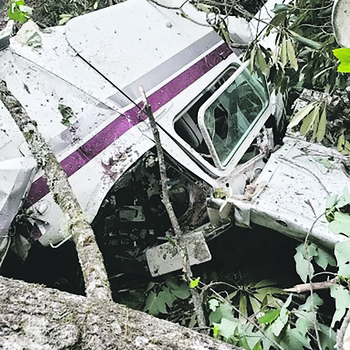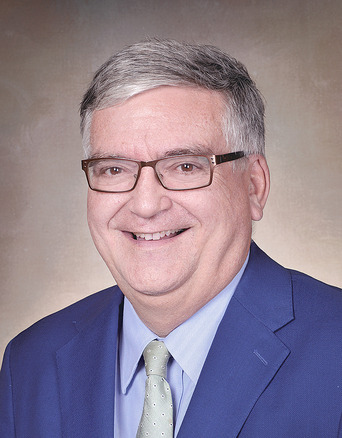
A platform that encourages healthy conversation, spiritual support, growth and fellowship

NOLACatholic Parenting Podcast
A natural progression of our weekly column in the Clarion Herald and blog

The best in Catholic news and inspiration - wherever you are!
For air crash survivor, each day is God’s miracle
-

By Peter Finney Jr.
Clarion Herald
Sean Harrison doesn’t remember the moment his rented Cessna 172 dove at 70 mph into the 80-foot pine trees of a North Carolina Catholic summer camp in the Blue Ridge Mountains, because, how could he?On June 16, 2022, Harrison, the father of four, was piloting the small plane with two passenger friends – Michael Franco and Jeffrey Trufant – above the treetops so they could take dramatic aerial pictures of the camp that Harrison’s and Franco’s children were attending.
It was around 4 p.m., and the weather was fine. A thunderstorm had passed through earlier in the day.
“The way that Michael and Jeffrey say it, we were flying, and I started to say, ‘Hey, guys, we’re in trouble! We’re in trouble! Something’s not responding.’ About 10 seconds later, we started hitting the trees. We barreled into the woods.”
If there is one thing certain about flying a Cessna into a forest, it is this: No one gets out alive.
A Federal Aviation Administration investigator who came to the crash site, which was just to the left of the camp’s outdoor chapel’s small wooden benches, said as much.
“When planes go down in the woods, there’s usually death,” she told the camp’s owner.
“Even the FAA said it was a miracle,” Harrison said. Trufant, the camp owner’s son who was sitting in the back seat, was able to kick out a side window despite the crushed plane being flipped upside down. Trufant had a broken wrist and was bleeding internally, but he was able to extricate Franco, who was also seriously injured.
Trufant tried to pull Harrison, bleeding heavily from his head and right leg, out of his pilot seat, but nothing would budge. The seat belt had him strapped in.
Trufant, who knew every blade of grass at the camp, decided to stagger for help. It was about a half-mile to the camp office. No one had known the plane had gone down because it didn’t make a sound.
“No one knew we had crashed,” Harrison said. “The last memory I had was making a call to the Asheville (North Carolina) approach, as a courtesy, that we were going to be dropping off their radar to take some pictures. So, no one was looking for us. Another miraculous piece was that the plane did not catch fire. A lot of people said at the accident scene that there was a very pungent smell of gas.”
Over the next three weeks, as Harrison was rushed into multiple surgeries to repair a shattered right hip, a broken right arm and lacerated knee and torn patella tendon, Harrison was consumed with remorse.
It certainly helped that, amazingly, his friends were in no danger of dying, but he continued to second guess himself.
“As the pilot, there was such a feeling of guilt,” Harrison said. “I must have expressed that to my wife (Frances) in the hospital, and this was before I got to see Michael and Jeffrey. Obviously, when I knew they were OK, that cleared my mind a little bit, but I remember just feeling kind of broken. Both of those guys pulled me off to the side at different times and they were really stern with me: ‘Hey, man, we’re alive, right? Just let this go. We love you.’ It was helpful because these guys were still my friends. You don’t want people to hate you.
“It’s reassuring, but still, I was at the controls. What did I do? What didn’t I do? What could I have done? You just think about a lot of stuff. They were just very godly and stern and said, ‘Sean, don’t hold on to this.’”
In the subsequent months of investigation by experts from the FAA and the National Transportation and Safety Board, it was determined that wind shear may have played a part in the accident.Filled with gratitude
Eighteen months after the accident, Harrison is steeped in gratitude for his wife, his four children and for those who created a meal train and offered babysitting help during his recuperation. His shattered hip was pieced together with more than a dozen pins and doesn’t even hurt much. The worst residual damage is to his right knee, which has put something of a limitation on his pre-accident job of climbing 600-foot cell towers to install fixed wireless.
Harrison has always been something of an intrepid adventurer. He spent four years at St. Joseph Seminary College considering the priesthood, and, in 2005 after Katrina, he and another seminarian, now-Father Daniel Brouillette, chauffeured 92-year-old Archbishop Philip Hannan through military checkpoints as the former paratrooper chaplain made pastoral visits to first responders.
Do you know who I am?
He will always remember one drive across the Causeway with Archbishop Hannan, who had heard that the 82nd Airborne, his old WWII unit, was doing recovery work at St. Louis Cathedral.
Harrison’s car pulled up to the Mandeville toll booth, and a woman said the bridge was closed.
“There were two women in the toll booths, and the woman on the left goes, ‘Excuse me sir, you can’t go across. It’s closed,’” Harrison said. “And so, Archbishop Hannan leans over me and says, ‘Excuse me, I’m Archbishop Hannan.’ Basically, like, ‘I’m a big deal.’ She still said, ‘I’m sorry.’ Then, the lady in the booth on the right says, ‘Oh, baby, you know who that is? That’s Archbishop Hannan. He can go across. It’s OK!’”
Harrison recalls driving 70 mph across the bridge until the archbishop seemed to be getting a little flustered.
“Sean, you need to hurry up,’” Archbishop Hannan told him.
“So, I’m doing 80, and that’s not enough for him,” Harrison said. “So, I’m doing 90. I guess he didn’t tell me anything after 90.”
No easy answers
Harrison continues to wonder why he’s still here.
“A lot of people say, ‘Oh, God saved you’ and the way that comes across is that I was saved because I’m a great person,” Harrison said. “I’m not that great of a person. I want to be and I try to be. As you’re lying there, you’re wondering, ‘What did God save me for? Why am I here and that guy isn’t?’
“You discern as best you can, and you never get an answer. I’m resigned to the fact that there have been a lot of incidents since then where I’ve talked to people who were majorly affected by that accident, whether they were the first ones up there or were just in awe of the miraculous nature of it. I don’t know if I was saved for anything specific. Maybe it was just for this conversation or for all the conversations I’ve had with people – you know, there is a God.
“I don’t know the will of the Father, and you have to come to grips with that. I think it makes living a good life a little more palpable, because there are joys to still being here. I get to see my kids grow up. I get to be with my wife and friends and family. But, what if I had died? Maybe I would be with the savior. If I had died, would that have been the worst thing?”
Got back on the horse
Not really sure of how he would react, Harrison decided last year to get back in the air, if only to say he had done it.
“My wife is so wonderful; she never said ‘don’t,’” Harrison said.
In order to regain his license, he was required to contact a flight instructor and take a test flight.
A Cessna 172, the same model he flew to North Carolina, was waiting for him at Lakefront Airport. He sat for a while in the parking lot, reflecting on his life.
“Not having that memory, there wasn’t any PTSD,” Harrison said. “I was kind of welling up that I was here.”
Once the Cessna 172 left the ground, Harrison did routine maneuvers, “stuff that you would do for a flight review every two years.”
He did a grass field landing and takeoff. He flew across the lake. He soared over the trees.
“Recently, in the last few months, I kind of got to the point where I’m sure Frances would prefer me not to fly,” he said. “But, she’s such a great one she’s never said, ‘No, you can’t.’ But, I’ve basically got to the point where, you know, I don’t need to.”
Why do you want that?
Last month, Harrison drove to an airplane scrapyard south of Atlanta and picked up a 15-foot section of his Cessna that had been released by the NTSB. The tail section, with its identification number (N5064H), now sits on a trailer, near one of the cell towers Harrison services.
“November-5-0-6-4-Hotel,” he said. “I’ll never forget it. All the guys are saying, ‘Man, that’s cool.’ The girls are always like, ‘What are you going to do with that?’”
“I don’t know,” Harrison said. “I’ll figure it out later.”




